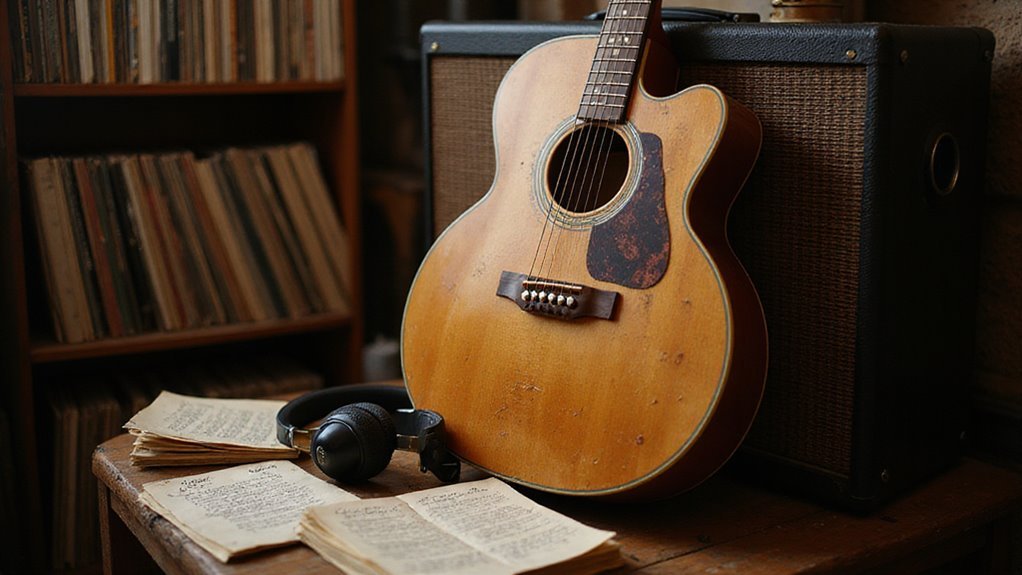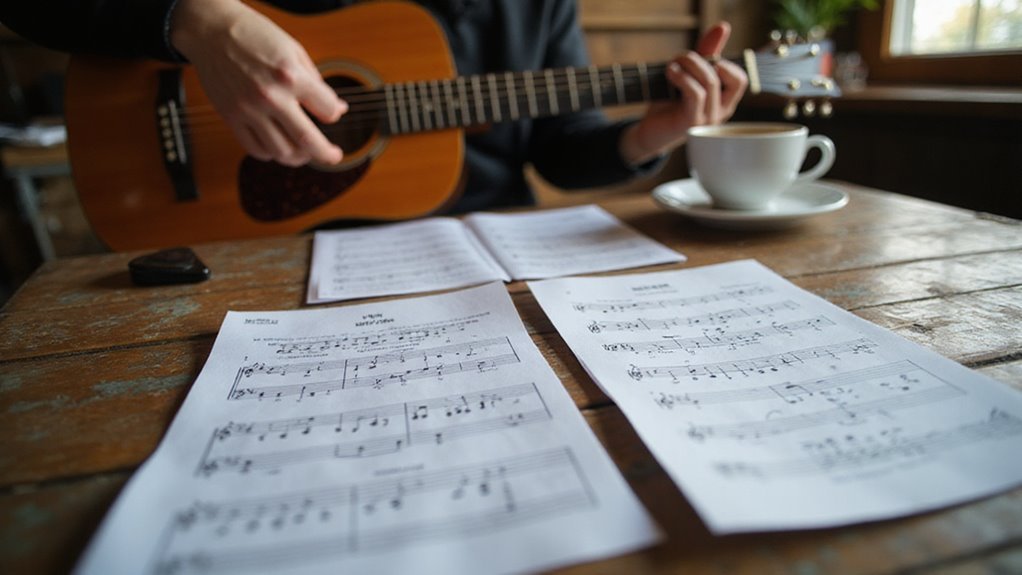Like Dylan going electric at Newport, learning guitar without reading music challenges conventional wisdom—but it might just be your path to musical freedom. You don’t need to decipher those little black dots on five lines to become proficient on the fretboard. Many guitarists, perhaps even your favorites, never learned traditional notation yet created sounds that changed music forever. I’ve seen complete beginners transform into confident players using only their ears and simple visual guides.
The Myth of Mandatory Music Reading for Guitarists

Why do so many aspiring guitarists believe they must learn to read music before they can truly play?
I think it stems from classical training mindsets that have seeped into modern guitar education, creating unnecessary barriers for beginners like you.
Truth is, many iconic guitarists never mastered standard notation.
Eric Clapton, Jimi Hendrix, Slash – they all developed their legendary skills through alternative methods.
Perhaps the pressure to read music actually discourages some talented players from pursuing their passion.
You don’t need sheet music to express yourself.
Tablature, chord diagrams, and learning by ear are equally valid paths to becoming the guitarist you’ve always wanted to be.
Famous Guitarists Who Never Read Sheet Music

I mentioned earlier that some legendary guitarists never learned to read music notation, and it’s worth taking a closer look at these musical pioneers.
You’re in good company if you can’t read sheet music. Eric Clapton, for instance, relied on his ear and intuition to create his distinctive blues sound.
Don’t let notation hold you back. Some of the greatest guitar legends created their masterpieces purely by ear.
And think about Jimi Hendrix – perhaps one of the most innovative guitarists ever – who transformed the instrument without reading a single note on a staff.
Slash is another example who crafted those iconic Guns N’ Roses riffs through feel rather than formal training.
Their success proves that your musical journey doesn’t require traditional notation skills.
Alternative Learning Methods for Guitar: Tablature and Chord Diagrams

Two popular alternatives have emerged for guitarists who don’t read traditional notation: tablature and chord diagrams. These methods have become the go-to learning tools for countless players like us who just want to make music without getting bogged down in theory.
Tablature, or “tabs,” shows you exactly where to place your fingers on the fretboard. It’s brilliantly simple – six horizontal lines represent your strings, and numbers indicate which fret to press.
Chord diagrams are perhaps even more intuitive, showing a visual snapshot of finger placement.
I think these approaches feel more natural for most beginners – you’ll be playing recognizable songs much faster than if you started with sheet music.
Developing Your Ear: The Path to Musical Intuition
How does a musician develop that magical ability to play what they hear in their head? It’s a journey that begins with actively listening. When you train your ear, you’re building a bridge between imagination and execution – something that, I think, reveals true musical freedom.
Many guitarists who can’t read traditional notation rely on their ears instead. This skill isn’t just useful; it’s transformative.
- Try mimicking simple melodies from favorite songs
- Practice identifying chord progressions by sound alone
- Record yourself playing, then listen critically
- Sing what you want to play before attempting it
- Jam regularly with other musicians to test your ear
Striking the Balance: When Theory Knowledge Matters
While developing your ear opens doors to intuitive playing, there’s a complementary world of music theory that can transform your guitar journey. You don’t need to read music, but understanding chord construction and scale relationships will help you connect with fellow musicians on a deeper level.
Perhaps the sweet spot isn’t choosing one approach over another, but knowing when each matters. Some days, I think it’s better to just play what feels right. Other times, understanding why certain notes work together reveals creative possibilities you might otherwise miss.
Trust your instincts, but don’t shy away from theory when it serves your goals.
Frequently Asked Questions
How Long Does It Take to Become Proficient Without Reading Music?
You’ll become proficient in 6-12 months with consistent practice. Your dedication and learning style matter more than notation skills. Many guitarists thrive using tablature and ear training instead.
Can I Compose Original Music Without Knowing Standard Notation?
Like Hendrix, you can create amazing original music without standard notation. You’ll connect more deeply with your compositions as you rely on your ear and intuition to craft unique sounds that reflect your true voice.
Are Certain Guitar Styles Harder to Learn Without Reading Music?
Yes, classical and jazz guitar can be tougher to learn without reading music. You’ll find it harder to master complex harmonies and specific techniques that these styles demand.
Will Not Reading Music Limit My Professional Opportunities?
Over 80% of professional guitarists don’t read traditional notation. You’ll face some limitations in classical and session work, but you’re in good company with icons like Hendrix and Clapton who thrived without it.
What Digital Tools Can Help Guitarists Who Don’t Read Music?
You’ll find several digital tools helpful, including guitar tablature apps, chord chart generators, ear training software, digital tuners, looping pedals, and YouTube tutorials showcasing techniques by other non-readers.
Conclusion
Your guitar journey needn’t be impeded by musical hieroglyphics. Whether you’re developing your auditory gifts or exploring alternative visual guidance systems, success awaits without traditional notation. I think the most important thing is just showing up daily with your six-stringed companion. Perhaps the greatest musicians weren’t those who mastered the dots and lines, but those who let their fingers dance to the rhythm of their souls. You’ve got this!